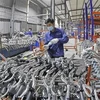Small- and medium-sized enterprises (SMEs) are the backbone of Asia’s economies, but they need better access to finance to grow and generate badly needed new jobs for the region, the Asian Development Bank (ADB) said in a new report.
"Most of Asia’s smaller firms are faced with difficulties in obtaining finance,” said Noritaka Akamatsu, Deputy Head of ADB’s Office of Regional Economic Integration, which produced the inaugural edition of Asia SME Finance Monitor, released on April 4.
“SMEs need to be able to tap a wider range of nonbank financing options in addition to bank loans, including capital markets if they are to realise their potential,” the ADB official added.
SMEs - defined differently in different countries but generally with a small workforce or low assets - make up 98% of all businesses and provide jobs for 66% of the labor force in Asia, but they represent only 38% of the region’s gross domestic product (GDP), indicating that governments can boost economic growth by developing SMEs.
However, small firms have trouble getting the finance they need to grow. They lose out to larger companies where bank loans are concerned, particularly with banks cutting back their lending to SMEs in the wake of the 2008-2009 global financial crisis as they avoided risk and sought financial stability.
Although many governments have developed comprehensive policy frameworks to promote SME growth, most measures focus on helping SMEs get loans from banks, the report said.
It added that more needs to be done across the region to incorporate nonbank financing options into national policies and nurture other options, such as increased use of asset-based finance and capital market instruments.
The report, which includes data on SMEs in 14 countries in the region, found that as the world economy becomes increasingly interlinked, SMEs that are part of intricate global supply chains will need access to further trade finance, supply chain finance, and innovative funding models that enable them to expand their business globally.
The new report is being launched in tandem with a joint ADB-OECD study on SME access to finance, which looks at lessons for the industry from the 2008-2009 global financial crisis and Europe’s sovereign debt troubles.-VNA
"Most of Asia’s smaller firms are faced with difficulties in obtaining finance,” said Noritaka Akamatsu, Deputy Head of ADB’s Office of Regional Economic Integration, which produced the inaugural edition of Asia SME Finance Monitor, released on April 4.
“SMEs need to be able to tap a wider range of nonbank financing options in addition to bank loans, including capital markets if they are to realise their potential,” the ADB official added.
SMEs - defined differently in different countries but generally with a small workforce or low assets - make up 98% of all businesses and provide jobs for 66% of the labor force in Asia, but they represent only 38% of the region’s gross domestic product (GDP), indicating that governments can boost economic growth by developing SMEs.
However, small firms have trouble getting the finance they need to grow. They lose out to larger companies where bank loans are concerned, particularly with banks cutting back their lending to SMEs in the wake of the 2008-2009 global financial crisis as they avoided risk and sought financial stability.
Although many governments have developed comprehensive policy frameworks to promote SME growth, most measures focus on helping SMEs get loans from banks, the report said.
It added that more needs to be done across the region to incorporate nonbank financing options into national policies and nurture other options, such as increased use of asset-based finance and capital market instruments.
The report, which includes data on SMEs in 14 countries in the region, found that as the world economy becomes increasingly interlinked, SMEs that are part of intricate global supply chains will need access to further trade finance, supply chain finance, and innovative funding models that enable them to expand their business globally.
The new report is being launched in tandem with a joint ADB-OECD study on SME access to finance, which looks at lessons for the industry from the 2008-2009 global financial crisis and Europe’s sovereign debt troubles.-VNA



















